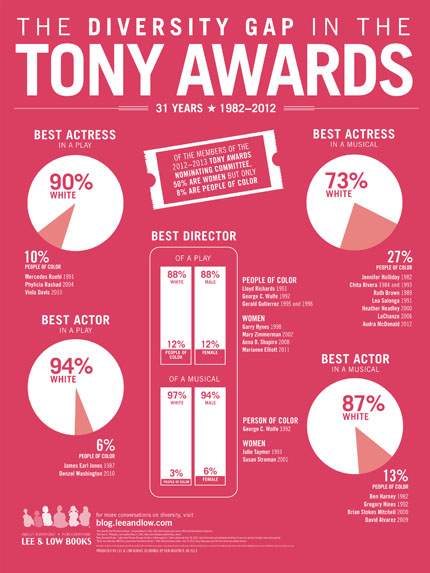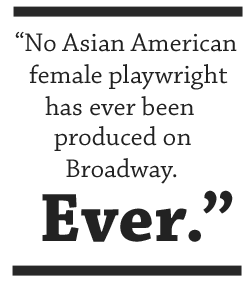Publishing diverse children’s books for more than two decades has given us a unique perspective when it comes to diversity. While our mission is to bring more diverse books to children, we hope our efforts as activists keep the wider conversation on race and inequality in the spotlight. Our other Diversity Gap studies on the Tony Awards, the children’s book industry, US politics, The New York Times Top 10 Bestseller list, Sci-Fi and Fantasy Films, Silicon Valley and the Academy Awards revealed a disturbing trend in ethnic and gender representation. We decided to focus on the television industry next. Continue reading
Tag Archives: representation
Why Hasn’t the Number of Multicultural Books Increased In Eighteen Years?
Note: This post was originally posted in June 2013. An updated study with new statistics can be found here. The infographic below has also been updated.
Since LEE & LOW BOOKS was founded in 1991 we have monitored the number of multicultural children’s books published each year through the Cooperative Children’s Book Center’s statistics. Our hope has always been that with all of our efforts and dedication to publishing multicultural books for more than twenty years, we must have made a difference. Surprisingly, the needle has not moved. Despite census data that shows 37% of the US population consists of people of color, children’s book publishing has not kept pace. We asked academics, authors, librarians, educators, and reviewers if they could put their fingers on the reason why the number of diverse books has not increased. Continue reading
Where’s the Diversity? The Tony Awards Looks in the Mirror
Though we are a publisher of children’s books, part of our mission is to look at diversity issues with a critical eye and see whose stories are not being told. As part of that mission, over the next several months we will be looking at several different arenas and talking to experts to see if patterns of inequality repeat themselves in different places. We hope our research will cast a light on the challenges – and opportunities – facing women and people of color today.

Since the Tony Awards will be presented on June 9, 2013, we decided to collect some data to see if a diversity gap exists in the theater. See our infographic above. While we cannot claim expertise in other fields outside of children’s books, we were fortunate to receive valuable insight from playwright/actor Christine Toy Johnson, who has spent the last fifteen years conducting dialogue with the entertainment industry to increase diversity in the theater and beyond.
 CHRISTINE TOY JOHNSON is an award-winning writer, actor, filmmaker, and advocate for inclusion. Member: BMI Workshop, Dramatists Guild, ASCAP, AEA, SAG-AFTRA, Asian
CHRISTINE TOY JOHNSON is an award-winning writer, actor, filmmaker, and advocate for inclusion. Member: BMI Workshop, Dramatists Guild, ASCAP, AEA, SAG-AFTRA, Asian ![]() American Composers and Lyricists Project (founder), executive board of Alliance for Inclusion in the Arts, elected leadership of Actors’ Equity Association (and co-chair of the union’s EEOC), founding steering committee member of AAPAC. {Read more}
American Composers and Lyricists Project (founder), executive board of Alliance for Inclusion in the Arts, elected leadership of Actors’ Equity Association (and co-chair of the union’s EEOC), founding steering committee member of AAPAC. {Read more}
How old were you when you knew you wanted to perform onstage?
I can’t remember an age when I didn’t want to perform onstage. I was the kind of kid who made my parents’ holiday guests watch my dramatization of “The Twelve Days of Christmas” every year. I started working professionally (and joined Actors’ Equity Association) the summer I graduated from high school, and against all odds, I have made my living in the arts ever since, as both an actor and a writer.
Since you have been involved in the theater for so long, how have you seen the theater world change? Do you feel that the number of roles available to people of color has increased over the years?
Things have gotten better for people of color, for sure, but there is obviously a lot of room for improvement.
I want to preface all of this by saying that I can only really speak from the perspective of being an Asian American actor and writer. I can’t presume to know what it’s like to be African American, Latina, Native American, etc., but the stats I’ve included from AAPAC (see below) will be able to address this question from a more objective point of view.
Back in 1991, I got a chance to play Julie Jordan in a production of CAROUSEL at the Hangar Theatre in Ithaca,  New York, which was a watershed moment for me. Not only was I shocked that I was being given the opportunity to audition (back then, a rare occurrence), but after I booked the job, working with a director and company of actors that supported me and believed in my ability to transform into a non-Asian character in a classic golden age musical gave me the confidence to go for and go on to play many, many more classic non-Asian leading lady roles. The power of encouragement and affirmation from your peers cannot be underestimated.
New York, which was a watershed moment for me. Not only was I shocked that I was being given the opportunity to audition (back then, a rare occurrence), but after I booked the job, working with a director and company of actors that supported me and believed in my ability to transform into a non-Asian character in a classic golden age musical gave me the confidence to go for and go on to play many, many more classic non-Asian leading lady roles. The power of encouragement and affirmation from your peers cannot be underestimated.
As a playwright/librettist/lyricist, I am also acutely aware of the number of writers of color that are being produced, which is a key part of this puzzle. (More on that in a later question.) Personally, I am conscious of always either including an Asian American actor in my written work or telling an aspect of an Asian American character’s story. I believe that the only way we’ll see our roles increase is if more of our stories are produced (written by and/or about us), and/or if more playwrights/directors/producers are open to having people of color play non-race specific roles they write/direct/produce.

